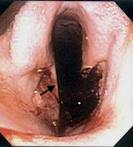This is a condition affecting the horse’s larynx that results in a significant decrease in the size of the horse’s airway diameter as well as some degree of respiratory noise (“roaring”). The cause for the decrease in airway diameter is secondary to a neurologic paralysis of the arytenoid cartilages covering the opening to the trachea. This paralysis, which is much more common on the left side of the larynx and in large breed horses such as Thoroughbreds, Warm Bloods, and Draft Horses, results in the larynx being unable to fully open, which can result in respiratory noise in mild cases and significant exercise intolerance in more severe cases. Unfortunately, this disease is progressive and worsens over time. The rate of progression can vary from horse to horse, however. Clinical signs seen with this disease include whistling, roaring, and exercise intolerance.
Diagnostics
Standing video-endoscopy, dynamic endoscopy, ultrasonography
Treatment options
Laser ventriculocordectomy
This procedure is performed under standing sedation to remove the ventricle and vocal cord from the horse’s upper airway using a laser fiber passed through the endoscope. This procedure can be performed alone in the case of horses that simply make a respiratory noise when performing, but it is usually coupled with a laryngoplasty procedure for horses demonstrating any degree of exercise intolerance.

Laryngoplasty (“Tie back” procedure)
While this procedure used to typically be performed under general anesthesia, it is now most commonly performed under standing sedation with local anesthesia. A small incision is made in the throat latch region on the left side of the horse’s neck, and a permanent suture is placed in the arytenoid cartilage to pull it back and out of the airway, thus allowing air to flow more freely as the horse inhales. This is the best treatment for cases with exercise intolerance.



